|
Dimensions & Weight
Dimensions & Weight
Case Material
Case Features
Case Access Type
Switch Type
Reflector Type
Lens Type
Bulb Type
Circuit
Beam Type
Beam Characteristics
Overall Output
Nominal Color
Battery / Power Type
Battery Life (advertised)
Environmental Protection
Accessories
Special Items of Note
Warranty
Retail Availability & Cost |
.......
.......
.......
.......
.......
.......
.......
.......
.......
.......
.......
.......
.......
.......
.......
.......
.......
.......
.......
.......
.......
|
1LED (Black) L=3.25",Dia=.5"
Weight W/Bat.= 23gms
3LED(Stainless Steel) L=3.65",Dia=.5" Weight W/Bat.=
50gms
CNC machined T6 Aluminum / Stainless Steel
Fine machining/Removable head/Key ring or Lanyard hole
Head is removable for battery replacement
Twist On/Off head section
1LED (Black)-satin semi-parabolic | 3LED(Stainless Steel) None
None
One or Three 'Snow' High Power 5mm Nichia Type
Proprietary
1LED (Wide) | 3 LED (Spot)
1LED (Wide combination) | 3 LED (Spot)
1LED (13CP) | 3 LED (39CP)
1LED (5000ºK) | 3 LED (5000ºK)
1 x 1.5V AAA
1LED-8 hours to 50% | 3LED-5 hours to 50%
'O' ring at section joint between head and body- Sealed Emitter
Detachable key ring tailpiece / split ring (Heads are interchangeable)
Excellent fabrication quality / NOTE:
3 LED models are discontinued
1 year warranty / 30 satisfaction guarantee
$34.95 (1LED High Power/Snow) As Evaluated - http://www.peakledsolutions.com |
|
Form Factor & Build
|
1-Classification-
The Peak LED Solutions series of pocket flashlights
are among the most comprehensive range of top quality mass production
LED flashlights available. Within the limitations of the 5mm
Nichia type LED, the designers of the Peak line have managed
to offer a wide array of lights using 3 metals, 2 LED calibers,
4 Battery types and single as well as multiple LEDs
(Peak Multi-LED Lights were discontinued shortly after this
evaluation was completed) . This range
seems to have been carefully calculated to satisfy almost every
need within the 5mm LED market. The Peak LED Solutions Matterhorn
are an important series of lights for several reasons. The most
important factor is that the Matterhorn is the longest and slimmest
light that we considered to be viable as a Key chain light.
Both the 3 LED as well as the 1 LED versions are powered by
a ubiquitous and potentially rechargeable battery type- the
AAA size. That the Matterhorns pay cursory homage to the venerable
and quintessential Key chain light of the past 10 years, the
MAG Solitaire is telling.The aluminum 1LED Matterhorn is also
a near clone of another venerable key chain light, the currently
discontinued ARC-1XAAA. While the One and Three LED models use
the same battery, they deliver rather different beam patterns
as well as brightness levels and run times. It's easy to see
therefore how easy it would be to locate the ideal light for
a task based on the numerous permutations offered by Peak. The
Stainless Steel 3LED Matterhorn is a formidable piece of metal
- easily of use as a Kabutton in addition to being a flashlight.
Toss it into a sterilization fluid and it fits in with a surgeons
tool kit-making it ideal for the medical arts or scientists
in strictly sterile environments. The lightweight aluminum 1LED
version is sturdy but light enough to be an ideal choice for
a Key chain or as a main light for an outdoors person, journeyman
or soldier.
2- Geometry- These lights are a radially symmetrical
cylinder with a symmetrical Key ring attachment tail flange.
3- Build Quality- The Matterhorns
are precision made by CNC machine process. They are high quality
products manufactured to exacting tolerances and strict standards.
All components are hand assembled, adjusted, finished and fitted
in the USA.
4- Physical Features - Both these lights derive
their aesthetic features directly from the (discontinued) ARC
1XAAA Key chain light.. The common characteristic of most such
lights is that they look like shortened pencils and the head
is barely distinguishable from the tail. In the case of the
Matterhorns, the head is clearly distinguishable
from the tail section. The faintly knurled aluminum version
promotes a sure grip and the rather minimalist look of the stainless
steel light- borders on the sublime. The heads of the 1LED Matterhorns
are customized with a reflector designed and fabricated to marshall
the emitted photons into a narrow combination beam that is approximately
140º in angle of coverage. The head of the 3LED version however,
lacks a reflector and projects the beams of three LED's in unison
to form a single narrow angled beam of light.
5- Wall Thickness- The aluminum wall thickness
of the battery tube is 1mm on both versions
6- Finish- As evaluated the 3 LED version is
satin high polished smooth natural stainless steel and the aluminum
of the 1LED version is protected by black hard anodizing of
type II.
7- Fit- There is no 'play' or rattle anywhere
in the Matterhorns. Substantial 'O' ring seals
prevent water from entering the head and the emitters are sealed
into the head assemblies - further preventing the seepage of
water into either the head or the battery compartment. There
is no front lens on either light.To say that the fit of these
lights is precise would be an understatement- they are exquisitely
precision fitted. A detail worth mentioning is that these lights
both include the proprietary Peak removable tail studs- allowing
them to be used as vertical standing lights for ceiling bounce
mode. These studs are also very precisely fitted and include
an 'O' ring that acts as a friction lock to prevent accidental
unscrewing of the tail studs from the body of the lights- especially
when they're subjected to vibrations or constant torque. |
| Ergonomics
& Mount Options |
1- Laterality
Dominance. The Matterhorns are ambidextrous.
2-Switch Activation The two Matterhorns
are activated somewhat differently from each other. The basic
model for the 1LED version is to use the head as the twist On/Off
switch. Indeed this is the way that the 3LED version may be
activated as well. The 3 LED Matterhorn however has an added
feature. It has an 'equal ended' body such that either end may
have the head attached to it and the other a twist for On/Off
switch that is threaded the same as the head and which then
has the tail stud screwed into it instead of LED and circuit.
This rather unique arrangement allows for either the head or
the tail to be twisted for On/Off switching. All that is required
therefore is that enough pressure be applied for the (-) negative
contact on the tailpiece to mate with it's corresponding end
on the battery.
3- Battery Changes are effected through removal
of the head (or tail in the case of the 3LED version) from the
body section. After a fresh battery has been inserted, the head
is then replaced for use.
4-Loss Prevention/Stowage-Peak LED lights are
offered either with the removable tail stud or a plain flat
tail. The tail stud and corresponding tapped tailpieces are
threaded in the standard 3/8"X20 - the second most common
photographic thread size in the world. We hazard to guess that
the reason that the more common 1/4"X20 thread was not
used is probably to do with optimization of holding strength
as against the depth of the tap. The narrower 1/4"X20 thread
would have had less holding power at the 3mm of depth that it
has inside the tail of the light than the wider (more surface
area) 3/8"X20. Each tail stud is provided with a generous
3mm diameter hole- through which an included 1/2" split
ring is inserted. Thus the lights may be attached to key rings,
additional terminal hardware, lanyards and other anchors or
tethers. |
| Affordances |
1-Controls- in normal use, light emits from
the front of the flashlight when activation occurs through
a full clockwise turning of the head (or tail in the case
of the 3LED version) . There is no follow-through after it's
fully On . A scant -2º anticlockwise turning of the head in
relation to the body conversely effects de-activation.
2-Component/Section Accessibility The head
section is threaded to the body section, allowing for access
into the battery compartment. The circuitry and emitter are
'potted' with an epoxy like compound into the bezel as an
integrated and non- modifiable assembly. The tail section
of the 3LED version is thus a second access point in that
model.
|
| Human
Factors & Usability |
1-Deployment The Matterhorns’
form factor and size suggest that they may be stowed and deployed
in a manner similar to other lights of this category. No sheath
or holster or tether are offered but aftermarket accessories
exists that may be used with these lights. Not all users will
feel a need to in any manner secure their lights other that
to simply put them down somewhere or drop them into a pocket.
These lights , like others of their kind are candidates for
neck-lanyard carry either around the neck or inside a pocket
with the lanyard attached to a belt loop. Such anchors make
locating and deploying the lights much easier.
2-Basic Use Model . The switch is at the
head end for both lights and the tail section of the 3 LED
model may be used as a switch as well. There are no buttons
to press or levers to throw, making the use model intuitive
and easy for anyone to learn.
3-Changing 'States'- Focus is fixed at the
optimal beam angle produced by the matched reflector (1LED
style) or LED silos ( 3 LED style). The twisting action for
activating/de-activating the light is standard for such lights.
4-Usage Options The Matterhorns
are small enough to use as key chain lights for keyhole location
or they may be pressed into service as a highly respectable
near to mid-distance torches. It's doubtless that they may
be used for a wide range of tasks. The twisting activation
model makes them impractical for signaling but they are highly
reliable survival quality lights that would easily withstand
the rigors of a grueling adventure as gracefully as they manage
the modest demands of everyday use.
|
| Beam
Quality & Characteristics |
1-Beam Characteristics-These
lights produce somewhat contrasting beams with the 1LED model
throwing a substantially wider combination style beam- suitable
for low level situational or context inclusive, illumination.
The 3LED model is decidedly brighter and of the soft spot variety
of beam- more suitable for distance illumination or context
exclusive illumination that 'focuses' on a narrow subject window
with much less illumination on surroundings.
2-Color compared to 5,500ºK (Daylight) Both
models we evaluated were of the SNOW and HIGH output trim levels.
Indeed they produce perfectly neutral beam colors 5,400ºK- even
tonality with no anomalies or chromatic gradations. Their beams
are the equivalent color temperature of a bright canopy of clouds
at mid day.
This makes them useful for all tasks that call for the highest
level of color differentiation such as: critical inspection,
forensics, navigation and short-term reading applications. Pressed
into use as supplementary illuminators in our photographic studio,
our photographer was able to use the Peak Matterhorns to create
highlights and to illuminate shadows in set-up pictures of other
flashlights lights under evaluation.
3. Recommended Filters - None required.
4-Context of Use These low power beams are
excellent for general near proximity searching and are bright
and focused enough to create decent direct ambient room lighting
in a small to average sized room and still delivers relatively
bright light through hand-held or self standing ceiling bounce
mode (18'X12' white ceiling + white walls).
5-Category The Matterhorn 1LED
creates a subject illumination in a category that we've codified
as a extremely Context Inclusive Illumination Window
(CIIW) as compared with the Matterhorn 3LED
which produces a beam of a Context Exclusive
Illumination Window (CEIW) (*5)
6-Usage Scenarios. Excellent interior navigation
in small / medium spaces. Respectable range for outdoor navigation
and close-up searching. Any situation demanding a a clean white
light for durations of between 5 and 8 hours (till 50% brightness)
7-Throw-Maximum Distance for Object
Identification or MDOI-Confidently differentiate our
test subject (a 3.5"X4.5"Black Wallet) from its immediate
surroundings (black asphalt street), from as far away as 8
feet (Matterhorn 1LED) and 18feet (Matterhorn
3LED). This test simulated a person searching for a
known object of known color/tone that may be difficult to distinguish
from its surroundings in ambient light. |
| Conclusions |
1-Summary Comments-The
Peak LED Solutions Matterhorns
are exquisitely well crafted pocket and key chain lights that
represent the best quality that a consumer may hope to obtain
off-the-shelf, through the Internet channel and at a price that
is reasonable in relation to the the quality of product fabrication
and performance that they represent. Given the enormous 100,000
Hr. life spans of each of the 5mm LEDs used in the Matterhorns-
an owner of either of these two lights should expect them to
last a lifetime or more with proper care and maintenance. Unseen
to the naked eye is sophisticated circuitry that manages the
energy in a single 1.5V AAA battery so as to extract the maximum
brightness balanced with the long runtimes . The
Peak LED Solutions Matterhorns are not the
brightest lights on the market in their size category- but they
do strike an equitable balance for someone who wishes to minimize
battery changes without giving up brightness altogether.
2- Outstanding features:
- Exquisite fabrication quality
- Extraordinarily bright and narrow (3LED)
and ultra-wide-angled, smooth beam (1LED)
- Simple activation switch has a familiar use model/functionality
and is not likely to malfunction
- Both use a ubiquitous and optionally rechargeable battery
type
- Hand selected LED emitters produce 'snow white' light
- Highly respectable battery runtimes
- Excellent customer relationship management
- Superb warranty
- Components are interchangeable between the two models
- Unique and usable tailpiece attachment and conversion solution
3-Value. Excellent value and investment as
against cost (3LED versions are likely to be scarce
and prized)
4-Areas Cited For Improvement A) Variable output
adjustment on 3LED version for greater flexibility B) Mirrorized
reflector for 1LED version C) All Peak lights
deserve more presentable packaging for gift giving D) Split
rings deserve to be furnished with medium duty snap clips for
quick attachment/detachment.
4.5 Stars-
Very Highly Recommended
|
| Pictures |
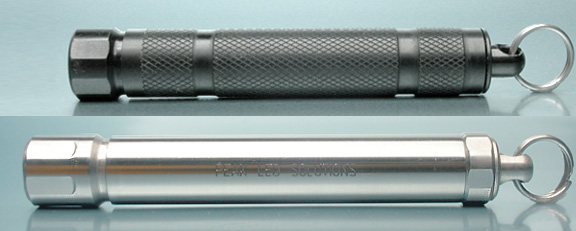
ABOVE,TOP-Matterhorn 1LED in Black HAIII | BOTTOM- Matterhorn
3LED in Stainless Steel
NOTE: 3 LED models are discontinued
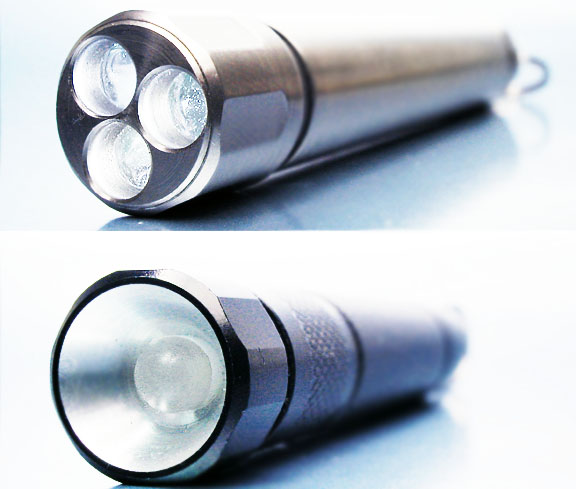
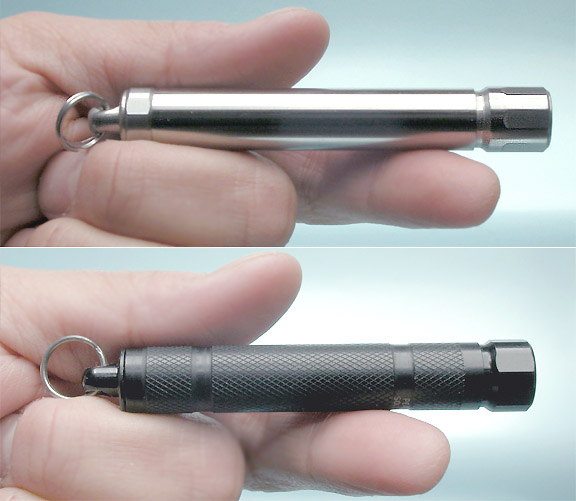
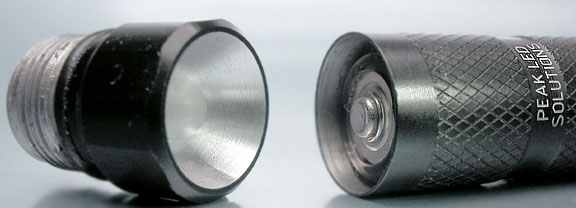

ABOVE,LEFT- Removable Tailpieces | RIGHT, TOP- Note: tailswtich
section of 3LED Stainless' tailpiece
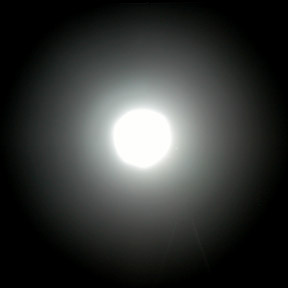

ABOVE, LEFT- (DBS) Matterhorn 3 LED | RIGHT (DBS) Matterhorn
1LED
|
| |
Footnotes:
(*2) Maximum Distance for Object
Identification (MDOI). The maximum distance that
a person without the aid of magnification-can with normal
or corrected vision, under a given ambient level of light,
identify an object of known size, and clearly distinguish
it from its surroundings. We have tentatively identified the
following scenarios for such measures:
- A single average sized person/body identification scenario
- Urban (city, inside buildings, dark alley, lit streets)
- Rural (countryside,farm residential backyard)
- Environmental (dessert, woods, wetlands, over water)
- Natural & manmade disaster (fire, flood/mudslide,earthquake,
hurricane /tornado,bombing scene, collapsed structure
etc)
- Small Inanimate Object (smaller than a shoe-box)
- Medium Inanimate Object (Black Plastic 33 Gallon (124Litre)
Garbage Bag stuffed with a big sleeping bag)
(*3) Usability testing results - in progress.
(*5) Context Inclusive Illumination
Window (CIIW) as compared with a Context
Exclusive Illumination Window (CEIW)
.
- CIIW describes a subject illumination
paradigm wherein the illumination target is the focus of
the beam's brightest disc or 'Hotspot' and peripheral objects
to the target are more dimly illuminated in a larger disc
that surrounds the focus or hotspot. This outer region is
also referred to as a corona or penumbra.
- CEIW describes a subject illumination
paradigm wherein the illumination target is the focus of
the beam's brightest disc or 'Hotspot' and peripheral objects
to the target are not sufficiently illuminated
to be easily discernable at the periphery
of subject beam's focus or hotspot.
©
2005 - Imägo Metrics - All Rights Reserved
Original standards designations (including acronyms) depicted
in this, as well as all of our evaluations are the exclusive
intellectual property of Imägo Metrics LLC and subsidiaries.
Reproduction without prior written permission is strictly
prohibited.
TOP OF PAGE |